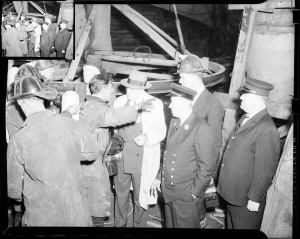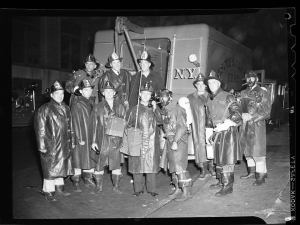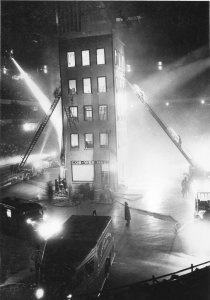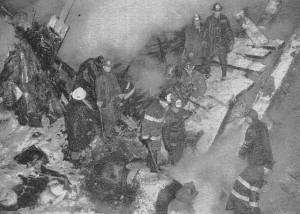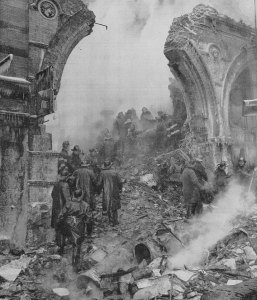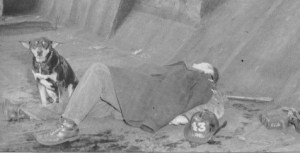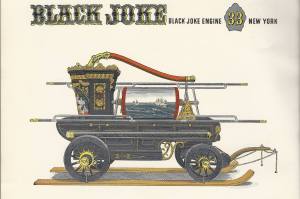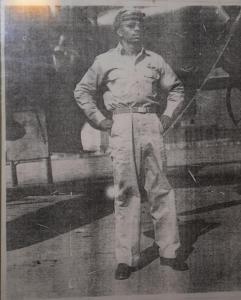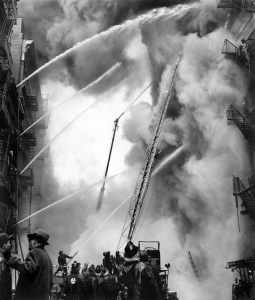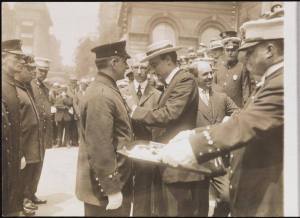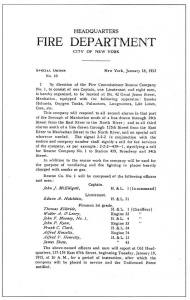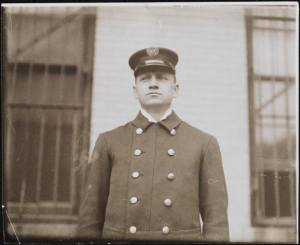From the Vault:
Great photo of Rescue 1 Captain Patrick Green reporting to the fire commissioner and having his “Scott bottle” changed. The scene of this difficult and dangerous major fire was inside the still under construction Brooklyn Battery Tunnel on May 14, 1947. The entire company made several trips through pressurized air-locks to reach the seat of the fire in the blazing tunnel. Green was awarded the Bennett Medal and every man working the tour in Rescue 1 (11 men) also were awarded a medal for their heroic operation. I think this is the only time in the history of the FDNY that ever happened. The fire took more than 2 -1/2 hours to extinguish.
Category Archives: History by Hashagen
FDNY Rescue 1 at Madison Square Garden
Great photo of Rescue 1 taken outside Madison Square Garden during one of the 1947 Midnight Alarm shows. There were several versions of the Midnight Alarm, where the FDNY showed their skills to a arena filled with people. The proceeds from the first show (1935) went to purchasing an ambulance for the department. Subsequent shows raised money to send the FDNY band to the American Legion convention in 1938, and this show in 1947 to help the FDNY Welfare Fund.
Salty Dog Apparel & Co.
Cool old school Firefighter apparel
Valentines Day FDNY 1958
From the Vault:
Valentine’s Day 1958
At 6:51 pm Manhattan Box 334 was transmitted for a fire in a six-story loft building at 137 Wooster Street. At the height of the multiple alarm fire, three floors of the Elkins Paper & Twine Company building collapsed trapping numerous members. Five-alarms were struck, and hundreds of off-duty members descended on the scene despite heavy snowfall, bitter winds and icy conditions. Rescue 1 was joined by Rescue 2 in a major tunneling and shoring operation in hopes of reaching two FDNY firemen and four members of the Fire Patrol trapped in the huge, frozen pile of rubble.
Conditions were so dangerous a crane was brought in to remove a large overhanging section of the building that was threatening to crash down upon the rescuers. The operation continued on into the following day, despite another major fire, a fourth-alarm in a lower east-side tenement only blocks away.
Sadly, the six men could not be saved.
Salty Dog
FDNY Sleds?
As far back as 1793 the volunteers of New York City had sleds built to help respond through the snow filled streets. In that year, because of heavy snow the December before, sleds were built for Engine Companies 17, 18, and 19. (19 even was allowed 2 additional members to help pull the rig- due to their longer responses.)
The cool picture of Black Joke Engine 33, shows their goose-neck pumper fitted with “runners” for hauling the machines through heavy snow. The other picture shows E-33 on the deck of a ship at the foot of Wall Street during the Great Fire of 1835. They were relaying water from a patch of open river to other pumpers on shore. Remember, all pumping then was done by hand!
* I have found no other mentions of the paid FDNY of using sleighs except the below photograph.
FDNY Lt. John Mulzac
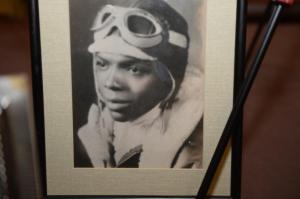
Retired FDNY Lt. John Mulzac, a Tuskegee Airman who took to the skies in three wars, died this week.
He was 91.
Mulzac, a Brooklyn resident who was affectionately called Daddy John, was an original member of the elite Tuskegee Airmen, a group of 994 pilots who in World War II became the first African-American aviators in the history of the U.S. armed forces.
To his family, Mulzac, who died Sunday, was also a prankster and storyteller whose barrier-breaking history spoke for itself. But it was a tale the Bedford-Stuyvesant man enjoyed sharing nonetheless.
“They said that we could never fly airplanes, were not capable of flying airplanes,” Mulzac recounted to an auditorium of students at St. Saviour High School in Brooklyn in 2001. “But there were some people on our side.” The heroism shown by the Tuskegee Airmen is said to have influenced President Harry S. Truman’s decision to desegregate the military in 1948. The airmen were awarded the Congressional Gold Medal in 2006, the highest honor bestowed by Congress.
“Despite the tough times of segregation he went through, he always felt this was the best country in the world,” said son Henry Mulzac, 60, a retired NYPD detective. “He was so grateful for what this country did for him and felt the service was worth it.”The pioneering pilot moved from manning flight controls to manning fire hoses when he became a smoke eater for the FDNY in 1947. He also started a family with his wife Beatrice, who pinned on his pilot wings at his graduation from the Tuskegee Institute in Alabama in 1944. When the country called on Mulzac again, he left the firehouse to fly missions in the Korean and Vietnam wars as a reservist.
He retired from the Fire Department in 1967 as a lieutenant, then worked as a sky marshal and as a U.S. Customs inspector before retiring for good to concentrate on his role as the patriarch of a sprawling brood of eight children, 22 grandchildren and eight great-grandchildren, his family said.
Mulzac, who died Sunday, is survived by his wife, eight children, 22 grandchildren and eight greatgrandchildren.
“He was a man of integrity and he loved his children, and in his life he wanted to see them all get an education and strive for the best,” wife Beatrice Mulzac, 88, said Thursday at his wake.
That drive was an inspiration for the success of his family. His son Robert Mulzac followed in his father’s footsteps and is a retired FDNY lieutenant. Two of his grandkids, Channing Frye and Tobias Harris, play NBA ball for the Orlando Magic.
“What an inspiration. I knew I could do and be whatever because of him,” his daughter, Karen Mulzac-Frye said after Mulzac’s wake.“Now that he’s gone, I’ve got to work even harder.”
FDNY Rag Shop Fire 1957
The Unbelievable Story of Collyers Mansion
John F. Mooney FDNY
From the Vault:
One Hundred Years Ago-
Another fireman chosen to be in the new Rescue Company was: John F. Mooney from Ladder Co. 4.
In 1912 Mooney made a daring rescue at 252 West 47th Street and was awarded the Wertheim and Department Medals.
On March 24, 1913 Ladder 4 arrived at the fire building, 320 West 58th Street, where a woman was clinging to a fourth floor window sill in the rear of the blazing building. The inner stairs were a sheet of flames so Mooney and Lt. Simpson hurried up the ladder to the roof.
Mooney laid flat on the roof and inched forward extending his head, then shoulders, then his upper body to the waist over the roof’s edge as the officer held his legs. Mooney leaned and stretched as far down as he could and grasped the woman by her hands. Using tremendous strength Mooney pulled her upwards. She and Mooney were now both dangling 60-feet above the ground. With an obstacle near the cornice Mooney extended himself even further to get into position to muscle her up and over the piece of iron work.
With one last effort the woman was raised up and over the ironwork and onto the roof.
This was the fourth time Mooney had been placed on the Roll of Merit.
The following year found Mooney on the steps of City Hall again. This time Mayor Mitchel was pinning the James Gordon Bennett and Department Medals on Mooney’s chest, for the best rescue of the year.
As the mayor pinned the two new medals on him he remarked, “You haven’t room for many more!”
He was an obvious choice for Rescue Company 1.
FDNY Rescue 1 Created
From the Vault:
One Hundred Years Ago Today-
After the tragic subway fire on January 6, 1915. FDNY Chief Kenlon and the commissioner put their plans for the creation of a new company- a rescue company, on the fast track. Kenlon chose a young captain, John J. McElligott of Ladder 1 to be the first commander. His lieutenant would be Edwin Hotchkiss of Ladder 21, who’d been cited for bravery and leadership at the recent subway fire. McElligott and Kenlon then hand-picked the remaining eight firemen (from hundreds of volunteers) who would become the first rescue men.
The applicants were checked out physically and evaluated for their skills. Being a proven fireman was of course the first critical criteria. Members who also had experience as mechanics, engineers, electricians, iron workers and riggers etc., were given preference. A tough physical and medical exam was given due to the severe work the new company was expected to encounter.
The new men were chosen, announced to the department on Special Order #10 and reported for the beginning of their specialized training. A new era in the fire service was beginning!
Next- the first rescue men. Paul Hashagen-author
